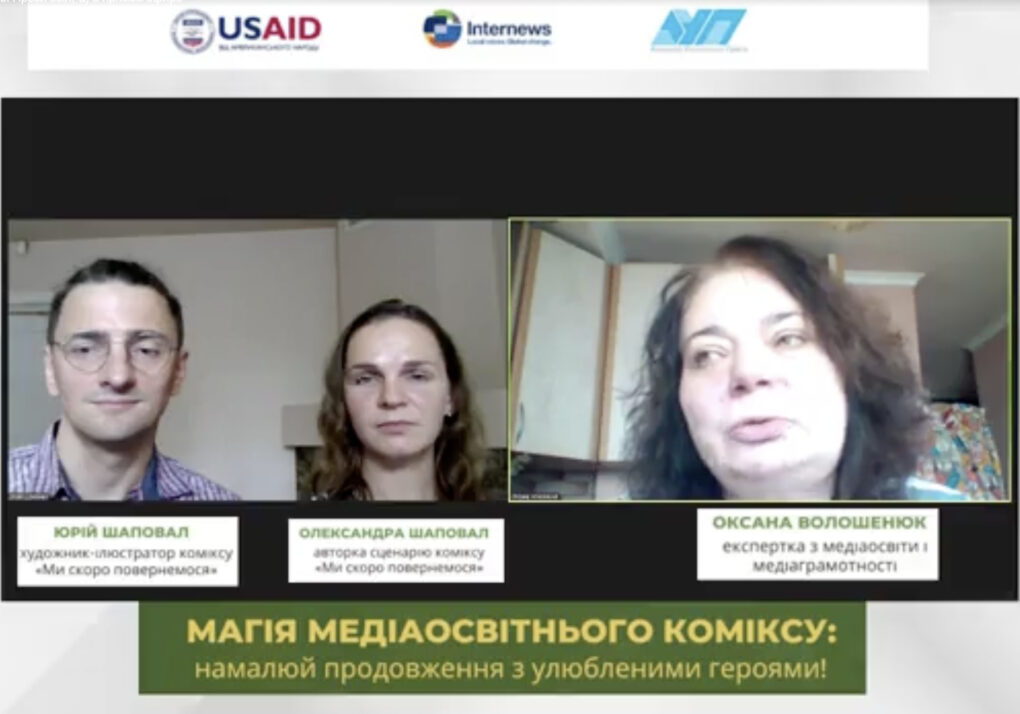
On August 8, the Academy of Ukrainian Press held a live broadcast "The Magic of a Media Education Comic: Draw a Sequel with Your Favorite Heroes!"
The live broadcast was dedicated to the media creativity contest. The authors shared their own experience of creating a comic book to inspire them to create their own works for the competition.
Oksana Voloshenyuk, an expert on media education and media literacy, author of textbooks and programs, said: "Today we are working on the sequel to the comic book We'll Be Back Soon, which has proved to be in great demand. And we invite everyone to join us in creating its sequel. Of course, they will be based on your own stories. Let us reveal a secret: the sequel will have a tab "comic within a comic", which will allow us to show not only the work of professional artists, screenwriters, art critics, but also those who are interested in comics and express themselves with it at the age of 4. I believe that the strength of this project is that we teach the youngest to use information, even in such small rudiments."
Oleksandra Shapoval, author of the script for the comic book We'll Be Back Soon, writer, promoter of children's reading, PhD in Art History, Junior Researcher at the Department of Screen and Stage Arts and Cultural Studies at the Rylsky Institute of Culture and Arts of the National Academy of Sciences of Ukraine, said: "A comic book is an art form in which a story is told not only through text and dialogues, but also through drawings. These parts interact and complement each other. Until recently, comics were considered a frivolous genre, a humorous genre, but over time, comics are gaining in popularity. Stories appear in a variety of forms and genres on serious topics. Comics can be used not only as a book for reading but also for educational purposes. They are a powerful tool that can be used for learning, in particular, to master some complex topics in the educational process. The comic book contains very little text and a lot of illustrations, which attracts children who are used to looking rather than reading, and it is easier for them to perceive the picture. Thanks to a beautiful, attractive picture, they start reading."
The author also shared step-by-step instructions for creating a comic book:
Yuriy Shapoval, illustrator, author of the visual solution for the We'll Be Back comic book, who has been creating computer game concepts, drawing comics and illustrations for about 20 years, shared his secrets of working on comics: "The first task of an artist is to talk to the author, to coordinate everything, to talk to the author about everything he has planned, it is important to determine the accents. You need to discuss each page daily because new ideas can appear, and the comic is improving daily.
After discussing the script, the artist collects references*. There are a lot of pictures on the Internet, and I collect a so-called mood board, where I lay out examples for myself. I go to the author with the mood board, and we look for a golden mean. A comic book is still a visual art, and a beautiful picture attracts the viewer and reader. Then, if we create a character, we add certain character references. Creating a comic book is complicated, so the first stage is done by the author, who creates the script. It's more difficult for artists because they are divided into categories. And it's also very important to make the characters so that their size matches the world."
The artist also showed all the stages of creating characters, from sketching in a notebook to a computer sketch and a painted version.
*References are samples of other finished works that set you in the right mood and serve as a guide to the final result.
Entries are accepted until September 10. The contest announcement is available here.
The event was held thanks to our joint project between the Academy of Ukrainian Press and the international organization Internews. Internews is implementing the Media Program in Ukraine with funding from the United States Agency for International Development (USAID). This program strengthens Ukrainian media and expands access to quality information.